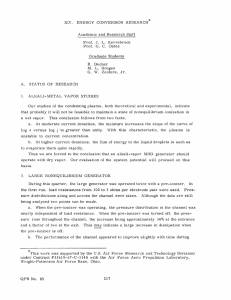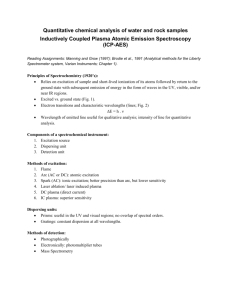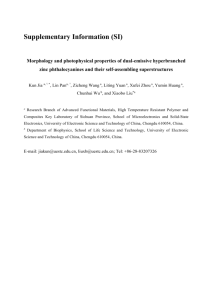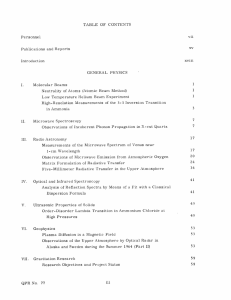J. L. Coggins R. Dethlefsen
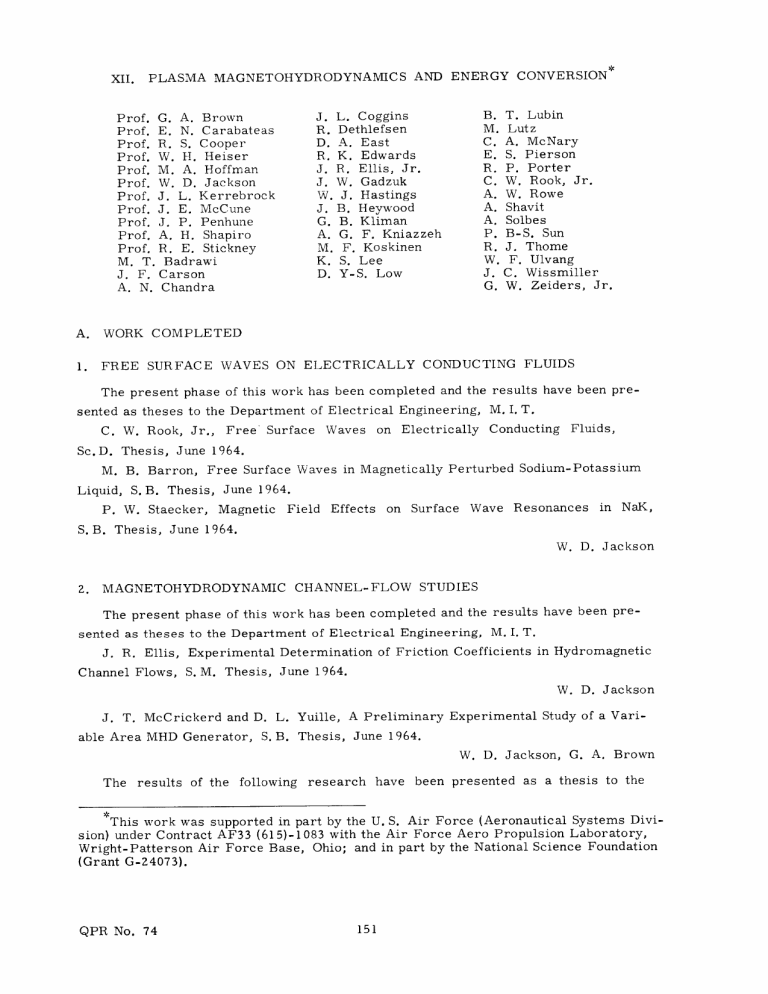
XII. PLASMA MAGNETOHYDRODYNAMICS AND ENERGY CONVERSION*
Prof. G. A. Brown
Prof. E. N. Carabateas
Prof. R. S. Cooper
Prof. W. H. Heiser
Prof. M. A. Hoffman
Prof. W. D. Jackson
Prof. J. L. Kerrebrock
Prof. J. E. McCune
Prof. J. P. Penhune
Prof. A. H. Shapiro
Prof. R. E. Stickney
M. T. Badrawi
J. F. Carson
A. N. Chandra
J. L. Coggins
R. Dethlefsen
D. A. East
R. K. Edwards
J. R. Ellis, Jr.
J. W. Gadzuk
W. J. Hastings
J. B. Heywood
G. B. Kliman
A. G. F. Kniazzeh
M. F. Koskinen
K. S. Lee
D. Y-S. Low
B. T. Lubin
M. Lutz
C. A. McNary
E. S. Pierson
R. P. Porter
C. W. Rook, Jr.
A. W. Rowe
A. Shavit
A. Solbes
P. B-S. Sun
R. J. Thome
W. F. Ulvang
J. C. Wissmiller
G. W. Zeiders, Jr.
A. WORK COMPLETED
1. FREE SURFACE WAVES ON ELECTRICALLY CONDUCTING FLUIDS
The present phase of this work has been completed and the results have been presented as theses to the Department of Electrical Engineering, M. I. T.
C. W. Rook, Jr., Free Surface Waves on Electrically Conducting Fluids,
Sc.D. Thesis, June 1964.
M. B. Barron, Free Surface Waves in Magnetically Perturbed Sodium-Potassium
Liquid, S.B. Thesis, June 1964.
P. W. Staecker, Magnetic Field Effects on Surface Wave Resonances in NaK,
S.B. Thesis, June 1964.
W. D. Jackson
2. MAGNETOHYDRODYNAMIC CHANNEL-FLOW STUDIES
The present phase of this work has been completed and the results have been presented as theses to the Department of Electrical Engineering, M. I. T.
J. R. Ellis, Experimental Determination of Friction Coefficients in Hydromagnetic
Channel Flows, S. M. Thesis, June 1964.
W. D. Jackson
J. T. McCrickerd and D. L. Yuille, A Preliminary Experimental Study of a Variable Area MHD Generator, S. B. Thesis, June 1964.
W. D. Jackson, G. A. Brown
The results of the following research have been presented as a thesis to the
*This work was supported in part by the U. S. Air Force (Aeronautical Systems Division) under Contract AF33 (615)-1083 with the Air Force Aero Propulsion Laboratory,
Wright-Patterson Air Force Base, Ohio; and in part by the National Science Foundation
(Grant G-24073).
QPR No. 74 151
(XII. PLASMA MAGNETOHYDRODYNAMICS)
Department of Physics, M. I. T.
D. W. McCowan, Experimental Investigation of an A-C MHD Induction Flowmeter,
S. B. Thesis, June 1964.
W. D. Jackson
3. EFFECTS OF A-C MAGNETIC FIELDS ON A SUPERCONDUCTING COIL
The present phase of this work has been completed by A. B. Buckman and the results have been submitted as an S. B. Thesis, entitled Effects of A-C Magnetic Fields on a
Superconducting Coil, to the Department of Electrical Engineering, M. I. T., June 1964.
W. D. Jackson
B. EFFECT OF HYDROGEN ON THE WORK FUNCTION OF CESIUM-TUNGSTEN
SURFACES
There have been definite indications recently that the performance of cesium thermionic energy converters may be increased by introducing appropriate additives into the
1-4 system. An investigation of the effects of various additives on the work functions of refractory metals is now being performed, and preliminary results for hydrogen on a cesium-tungsten surface are presented here.
1. Experimental Procedures and Results
The pertinent details of the experimental apparatus are shown schematically in
Fig. XII-1. The diode is similar to that used by Taylor and Langmuir.
5
A metal valve is provided so that the diode may be isolated from the pumps and the diffusion-type leaks. (The leaks were purchased from the K-B Glass Apparatus Co., Schenectady,
N. Y. )
-9
The entire system was baked at 3500C and outgassed until the pressure fell to the
10 -torr range. Measurements of the emission currents indicated an effective work function of 4. 60 ev for the bare tungsten filament.
The cesium capsule was broken, and the emission data obtained for a cesium temperature of -28 0 C agree well with the results of Taylor and Langmuir.
5
The measurements were reproducible from one day to another without flashing the filament, and were unaffected when the valve was opened to vacuum. The curve labelled Cs-W in Fig. XII-2 gives a typical example of the data.
One of the purposes of the present study was to attempt to gain a better understanding of the effects that had resulted in the degradation of emission in previous experiments involving cesium in glass systems. Our plan was to determine whether normal emission could be regained by opening the valve so as to evacuate the gases that may be causing the degradation. [The residual gases in a system may be affected strongly by the presence of cesium. For example, Best
6 has shown that large quantities of hydrogen
QPR No. 74
152
(XII. PLASMA MAGNETOHYDRODYNAMICS)
GUARD
RINGS
-----CESIUM RESERVOIR
Fig. XII-1. Cylindrical diode and gas manifold.
are evolved when Pyrex is exposed to alkali metals.] Much to our surprise, the degradation did not occur in the present diode even after numerous heatings of the entire system
(with the valve closed) to 150 C for many hours. The emission measurements obtained after each heating process usually agreed with the initial data, but occasionally the emission was anomalously high. [All measurements reported here were taken with the cesium reservoir at room temperatures (~28°C).] A typical example is presented in Fig. XII-2.
x10-3
ANOMALOUS DATA
H
2
-Cs-W
(PR, =lx10-
4 to r r
)
I x10
4
QPR No. 74
15
-x
IX 10
0.18 0.20 0.22 0.24 0.26
FILAMENT CURRENT (AMPS)
0.28
Fig. XII-2. Emission data for TCs = 28* C.
153
(XII. PLASMA MAGNETOHYDRODYNAMICS)
-3,
I
0 o o
-
I
0 o r w
)
- 6
1 1-6
1
2 3
EMISSION CURRENT
(NORMALIZED)
4
Fig. XII-3. Dependence of emission current on H2 pressure.
This condition of high emission tended to decay slowly back to normal, and the rate was accelerated significantly by raising the filament temperature momentarily to -1000
0 K.
The lack of stability indicates that the emission enhancement is not due to a strong chemisorption of residual gases such as oxygen on the filament surface. It was concluded from an ion gauge reading taken later upon opening the valve that the pressure of unknown residual gases had increased to more than 1 X 10-5 torr because of the heating processes.
The effect of hydrogen on the electron emission from tungsten in cesium was determined by means of the following procedure:
1. The filament current was set at a given value, and the emission measured after it attained a steady-state condition. (The cesium temperature was -28°C, as usual, and the valve was closed throughout this step.)
2. The pressure in the gas manifold (Fig. XII-1) was increased to a desired level by adjusting the hydrogen leak.
3. The valve was then opened so as to expose the diode to hydrogen; the change in emission was recorded.
4. These steps were repeated for different hydrogen pressures and filament temperatures.
It was found that the emission increased immediately to a steady value upon opening the valve to hydrogen; closing the valve resulted in a slow decrease in the emission current. The entire process appeared to be reversible, since normal emission could be re-established quickly by evacuating the hydrogen from the diode. A typical example of the data is shown in Fig. XII-Z for a hydrogen pressure of -l X 10 - 4 torr. (This pressure is the uncorrected ion gauge reading.) The dependence of emission on hydrogen
QPR No. 74
154
(XII. PLASMA MAGNETOHYDRODYNAMICS) pressure is indicated in Fig. XII-3.
2. Conclusions
The results of the preliminary experiments reported here indicate that at low temperatures and pressures a moderate increase in emission may be obtained by adding hydrogen to a cesium-tungsten system. (Similar results with hydrogen have been reported for a cesium-molybdenum system.
4 )
Since hydrogen is known to increase the work function of bare tungsten, it appears that the presence of hydrogen on the surface causes cesium to be adsorbed more strongly. The physical details of a binary adsorption process such as this are almost completely unknown at the present time.
This experimental program will continue, and the effects of other additives will be observed. Another description of the present work has been reported elsewhere.
8
R. E. Stickney
References
1. V. C. Wilson and J. Lawrence, Report on the Thermion Conversion Specialist
Conference, p. 121 (October 1963).
2. R. L. Aamodt, L. J. Brown, and B. D. Nichols, J. Appl. Phys. 33, 2080 (1962).
3. S. S. Kitrilakis, A. Shavit, and N. S. Rasor, Report on the Twenty-fourth Annual
Conference on Physical Electronics, M. I. T., March 25-27, 1964, p. 171.
4. B. S. Rump, J. F. Bryant, and B. L. Gehman, Report of Thermionic Conversion
Specialist Conference, Gatlinburg, Tennessee, October 1963, p. 236.
5. J. B. Taylor and I. Langmuir, Phys. Rev. 44, 423 (1933).
6. W. V. Best, Ph. D. dissertation in Physical Chemistry, University of Missouri,
1963.
7. J. Eisinger, J. Chem. Phys. 29, 1154 (1958).
8. R. E. Stickney, Report on the Twenty-fourth Annual Conference on Physical
Electronics, M. I. T., March 25-27, 1964, p. 243.
C. NONEQUILIBRIUM ELECTRIC CONDUCTIVITY OF WET AND DRY
POTASSIUM VAPOR
The principal objective of the work outlined here is to determine the electrical conductivity of flowing alkali metal plasmas in the temperature range 1000-2000K. Our interest in the alkali-metal vapors stems from their possible application as working fluids in high-temperature nuclear-electric space power systems that have magnetohydrodynamic generators.
For this application, it is desirable, for thermodynamic reasons, to expand the vapor in the MHD generator until it is partially condensed, or wet. The resulting plasma is
QPR No. 74 155
(XII. PLASMA MAGNETOHYDRODYNAMICS) unusual in that it contains small droplets of the condensed alkali metal, in interaction with the ionized gaseous plasma. The droplets influence the plasma in two ways. First, since the liquid alkali metal has a very low work function (approximately 2 ev), the droplets should emit electrons thermionically at lower temperatures than will lead to appreciable gaseous ionization. Second, because the droplets have very large cross sections for energy exchange with the electrons, their presence should greatly alter the energy coupling of the electrons to the gas.
This second point is of particular importance for the MHD generator application, since it appears that successful operation of the generator, at the stagnation temperatures permitted by nuclear reactors, may require the use of nonequilibrium ionization that is due to elevation of the electron temperature by Joule heating. Such elevation of the electron temperature is feasible only if the thermal coupling between the electrons and the gas is very weak, as it is in atomic gases.
We felt at the outset of the program that the complexity of the phenomena dictated an experimental, as well as theoretical, study of the plasma. Thus a major portion of the effort has gone into the construction of a small (10 gs - l flow rate) closed potassium loop capable of producing potassium vapor at saturation pressures up to approximately 2 atm (1100* K) and superheated to 2000* K.
This facility is unique in its temperature capability. We feel that its successful operation for periods of several hours at temperatures up to 1850* K is a significant step toward demonstration of the feasibility of high-temperature nuclear-MHD power systems.
The purpose of the present report is to describe the facility, the salient features of the analysis, and the preliminary experimental data that have been obtained. A more complete presentation is given in the doctoral thesis of A. W. Rowe.
1
1. Theory of Nonequilibrium Ionization in a Wet Plasma
In order to study the thermionic emission from drops and the energy transfer between electrons and drops we must have knowledge of the work function of the droplet and its inelastic cross section.
The work function has been estimated by solution of the potential model shown schematically in Fig. XII-4a, which leads to a correction 3e 2
/8(4wrEA) to the work function of a flat surface, s. This is compared with the form e
2
/4wEoA assumed by Einbinder.
z
The agreement between the prediction from the formulas and the ionization potential
(4. 32 ev) of potassium is encouraging.
The rate of thermionic emission from the drops is computed by assuming that any electron will escape which approaches the surface of the drop from within with the energy and angular momentum required for escape from the combined work function and net charge fields. The results are that for positively charged drops, the current
QPR No. 74
156
(XII. PLASMA MAGNETOHYDRODYNAMICS) q -e (1- ) q -e-
A r
ATOM RADIUS ~ 2.4 A
2
D0 11
RADIUS (A)
(b)
102
Fig. XII-4.
(a) Image charges induced in a spherical metallic drop.
(b) Drop electron work function for Z = 1.
of electrons is
I=
4wme
,
(kT) e
- W
Z/kT
1
+ kT ' where
W = s + [ + (Z-1)] e
2
4TrE A' o and Z is the drop charge after emission of the electron.
For negatively charged drops,
I =
4m h
2 -[Wz+V(r)]/kT
(kT) e
QPR No. 74 157
(XII. PLASMA MAGNETOHYDRODYNAMICS) where
V(r) -4E
2
A [-0. 427Z+0. 079Z2+0. 0058Z 3+0. 000121Z 4].
Similar criteria are applied to the impact of electrons upon the drops. It is assumed that any electron intersecting the surface of the drop is thermalized at the drop temperature. The cross section for such encounters is, then, for positively charged drops,
S
= rA 2 e s) and for negatively charged drops,
S
D
= wrA
2 e
-V()/kTe
With these cross sections, it is possible to estimate the electron temperature from a balance between Joule heating of the electrons and the losses resulting from elastic collisions with atoms and inelastic collisions with drops. This leads to the conclusion that
2J. E
T -T= ee
3 kN[6 VA + VD where J E is the Joule heating rate, N e is the electron concentration, and v
A and vD are the collision frequencies of electrons with atoms and drops, respectively. For atomic gases, 6 is approximately 2. It is convenient to refer the behavior of the wet gas to that of a dry gas by defining an effective 6 so that
ZJ.E
3kN 5 m e eff m e v a
A
Then
6 eff
6
1+ mAVD
6meV
A measures the effect of droplets on the electron temperature. This ratio is given in
Fig. XII-5 for potassium as a function of drop size and fractional condensation, X. We see that for as little as 5 per cent condensation, the depression of the electron temperature is very large if the droplets are from 10 A to 100 A in radius.
With these results, the charge state of the drops can be computed in terms of the
QPR No. 74
158
(XII. PLASMA MAGNETOHYDRODYNAMICS)
Sk= 250 A
0.6
0.4
10
3
MEAN DROP RADIUS ,
A
10
4
10
5
Fig. XII-5.
Effective electronic energy-loss with condensation fraction, X.
parameter in a wet vapor concentration by balancing the electron emission and capture rates. charged drops, the result is
For positively
N
Z
1 4wm e (kT)Z e e / 2rm e e
-W/kT
+ h
3
+ WZe kT e s
+ n
1 kT
Z2nmA
-Vi/kT where NZ is the concentration of drops of charge Z.
For negatively charged drops,
N
NZ-
N
Z
1 kT
N e
4rrm
4wm e (kT) e
-[WZ+V(r)]/kT h
Zrm e e
-V(r)/kTe
+n
1 kT
ZrrmA
Under conditions described elsewhere,
3 the ion concentration is determined by the
Saha equation n.N
1 e n
A
2rrm kT \3/2 e e h2
-Ei/kT e where E.
1 is the atomic ionization potential.
Charge neutrality requires that
QPR No. 74
159
(XII. PLASMA MAGNETOHYDRODYNAMICS)
00
Ne = n + I ZNZ' while the droplet charge distribution must satisfy
No
N X nA
-00 where n is the number of atoms per drop, and X is the fractional condensation of the vapor.
These relations can be combined to yield the electron concentration for either the equilibrium case (T =T) or for the more general nonequilibrium case (T eT). Typical
10
Drop Radius, A
Drop Radius, A
50 102 500 103
1016 re)
1014
E i012
0 1012
CZ
0
C a(
W 10
8
106
I 10 102 103 104 105 10 10 108
Number of Atoms Per Drop
Fig. XII-6.
Equilibrium ionization in a two-phase potassium vapor.
QPR No. 74 160
(XI. PLASMA MAGNETOHYDRODYNAMICS) results for the equilibrium case are given in Fig. XII-6. We see that for low temperatures there is a large increase in electron concentration for droplet radii near 10 A, but that the gain is much smaller at higher temperatures. Furthermore, the conductivities corresponding to these electron concentrations are quite low (~10-4 mho cm-1 at 1800 0 K for 50 A drops).
We are therefore led to the conclusion that nonequilibrium ionization is essential for successful operation of the MHD generator at temperatures below 20000 K. Droplet emission is not sufficient. The electron concentration is shown in Fig. XII-7 for a typical nonequilibrium case. Except for temperatures quite close to the gas temperature, the droplets reduce the electron concentration below its value for a dry gas at the same electron temperature; however, the effect is rather small.
The final conclusion from the theory, then, is that high conductivities should be realizable by nonequilibrium ionization, provided that the electron temperature is not depressed by inelastic collisions of electrons with droplets. The depression of electron temperature should be very large for drop radii less than approximately 1000 A.
T = 750
0
K
P = 0.027 ATM n = 2.6 x 10
17
/CM
3
DRY VAPOR-
750 1000 1500 2000
ELECTRON TEMPERATURE oK
2500 2750
Fig. XII-7. Nonequilibrium ionization of potassium vapor as a function of electron temperature, T e , for gas temperature, T = 750*K.
QPR No. 74
(XII. PLASMA MAGNETOHYDRODYNAMICS)
2. Potassium-Loop Facility
The experimental facility constructed for study of these phenomena is shown schematically in Fig. XII-8. It consists of a boiler, constructed of Haynes Alloy 25, a coiled tubular superheater constructed of tantalum, a condenser, and a low-temperature (100*C) return loop with a filter, MHD flowmeter, and pump.
Water-Cooled
Condenser Test Leads
Condensate Pipe-
Vacuum Tank
Magnet Fits Around
Test Section
Test-Section Region
Radiation Shields
Tantalum Resistance
Heater
Tantalum Superheater
Flare Fitting Joint
Haynes 25 Boiler
Reservoir
Condensate
Pump
Filter _ -- Electric Heaters
C_
I Ft
I
Fig. XII-8. Potassium-vapor generator.
The boiler and the radiatively heated superheater are in vacuum, to ensure protection of the tantalum components at the high furnace temperatures (up to 2000*K). A narrow tube, 18 inches long, also vacuum-jacketed, was provided between the superheater and condenser, to accommodate test sections, and to permit the application of a magnetic field in the plasma.
A degassifier (not shown in Fig. XII-8) connects the condenser to a forepump. It consists of a 1-inch tube, 120 inches long, maintained at 100* C.
For the experiments described here, a test section constructed of Lucalox (polycrystalline alumina) was mounted in the condenser, at the end of the test region (see
QPR No. 74 162
(XII. PLASMA MAGNETOHYDRODYNAMICS)
DOUBLE WIRE
THROAT
20-MIL
TUNGSTEN
LUCALOX
(A1
2
0
3
)
3"
DIA
-
----
1.5cm
2.0cm
EARTHED
ELECTRODE25c
MOLYBDENUM
HOLDER 3
DIA
3/8"
Fig. XII-9. Test-section form and proportions.
Fig. XII-9). The test leads were carried out of the condenser by means of heated ceramic insulators, and the test section itself was heated in an attempt to prevent shorting of the leads by potassium condensation. In fact, such shorting limited the operating pressure to -0. 02 atm. This difficulty can be eliminated by more effective heating.
The configuration of the test section was such as to give a flow Mach number of
-0. 6 in the measurement region. With the vapor just saturated at stagnation conditions, such an expansion results in 2 per cent wetness in the test section (X = 0. 02). By varying the amount of superheat, it was then possible to change continuously from a dry vapor to one with 2 per cent condensation.
Measurements of the conductivity of the vapor were made by passing current axially through the gas, from the bottom electrode to the upper (double) tungsten-wire electrode.
The potential drop in the gas was measured by means of the two central floating probes.
In previous experiments
4 this technique has permitted satisfactory determination of the bulk conductivity of a plasma.
3. Experiments
Some typical results of such measurements are given in Figs. XII-10, XII-11, and
XII-12. In Fig. XII-10, the conductivity of dry potassium vapor at -1500
0
K and
0. 005 atm is presented as a function of the current density flowing axially in the test section. The theoretical curve is that predicted by the simple two-temperature theory given by Kerrebrock.
3
Data are presented for current flow both parallel (triangles) and antiparallel to the gas flow. In both cases, rather large potential drops existed at the downstream (upper) electrode, but the drop was much larger for current flow parallel to the gas flow.
It will be noted that the experimental conductivities are considerably larger than
QPR No. 74 163
Vg
I
" I I ,I I
PRESSURE ~ 0.005 ATM
TEMPERATURE ~ 15000K
S I lii
' 4
7
Fig. XII- 10.
Effective nonequilibrium conductivity of superheated potassium vapor at 0. 005-atm pressure.
10
I
10
-4
~ r i , 7 ,
10-
3
. . . . .~~~ i l i l
10-2 10-
I I I I I
CURRENT DENSITY (AMPS/CM
2
)
~~~~ r -o
10-2
1b\
THEORY (A- IOA)
17 70
0
1630
I
ESTIMATED FURNACE TEMPERATUF
1460
I
1340
I
1275 1230
I
200 400 600 800 1000
TIME (SECS.)
QPR No. 74 164
Fig. XII-11.
Effective over-all nonequilibrium conductivity measured during cooling of the superheater.
(XII. PLASMA MAGNETOHYDRODYNAMICS) those predicted by theory. The reason for this is not known at present; however, some seemingly plausible explanations, such as shorting of the test section, and a low potassium cross section, have been ruled out. This point requires further study, but there is a strong indication that a nonequilibrium plasma characteristic has been measured, in the agreement of the slopes of the experimental and theoretical curves.
100 I
10- PRESSURE ~ 0.005
ATM
0
I
S-2
10
10
-4
10
10
- 4
1
10
- 3
1 i I I IL[
10- 2 10-1
CURRENT DENSITY (AMPS/CM
2
)
1 10
Fig. XII-12. Effective nonequilibrium conductivity of wet potassium vapor and theoretical characteristics of a dry vapor at the same pressure and temperature.
This is very strongly reinforced by data taken as the superheater temperature was reduced, from an initial temperature of ~1500'K to approximately the boiler temperature. The conductivity, deduced from the over-all test-section voltage drop and current, is shown as a function of time and superheater temperature in Fig. XII-11.
The
-2 condition at time zero would correspond to a current density of '1 amp cm-2 in
Fig. XII-10.
According to the theory given above, the conductivity should fall, as the vapor passes into the wet region with decreasing superheater temperature.
A theoretical curve is superimposed on the data. It is based on the assumption that an equilibrium degree of
QPR No. 74 165
(XII. PLASMA MAGNETOHYDRODYNAMICS) condensation exists at each superheater temperature, and that all of the liquid phase is in the form of drops with a 10 A radius. The agreement is seen to be remarkably good.
It should be noted that the theoretical curve for drops of 100 A radius would be very far from that for the data.
Finally, the nonequilibrium behavior of the wet vapor has been studied in a manner analogous to that shown in Fig. XII-10 for dry vapor. The results, again based on the over-all test-section voltage, are given in Fig. XII-12. They can be explained by a 5eff of approximately 100, which is consistent with the value given in Fig. XII-5 for a droplet radius of approximately 10 A.
4. Conclusions
From the theoretical work we may draw the following conclusions.
1. The influence of droplets on the equilibrium conductivity of a wet alkali-metal vapor, although significant, is not important for practical MHD generators.
2. Small (approximately nucleation-sized) drops should depress the electron temperature, and the conductivity, in nonequilibrium plasmas.
3. Large drops (greater than 100 A radius) should have little effect on the conductivity.
The experimental work confirms conclusion 2, and thus indicates a serious problem that must be overcome if nonequilibrium MHD generators are to be operated with wet alkali-metal vapors. On the other hand, the successful operation of the loop at high temperatures suggests that the problems of extended operation of high temperature nuclear-MHD systems may not be insuperable.
J. L. Kerrebrock, M. A. Hoffman, A. W. Rowe, A. Solbes
References
1. A. W. Rowe, Nonequilibrium Electric Conductivity of Wet and Dry Potassium
Vapor, Sc. D. Thesis, Department of Mechanical Engineering, M. I. T., May 1964.
2. H. Einbinder, Generalized equations for the ionization of solid particles,
J. Chem. Phys. 26, 948 (1957).
3. J. L. Kerrebrock, Nonequilibrium ionization due to electron heating Part I.
Theory (to be published in AIAA Journal).
4. J. L. Kerrebrock and M. A. Hoffman, Nonequilibrium ionization due to electron heating Part II. Experiments (to be published in AIAA Journal).
QPR No. 74
166
